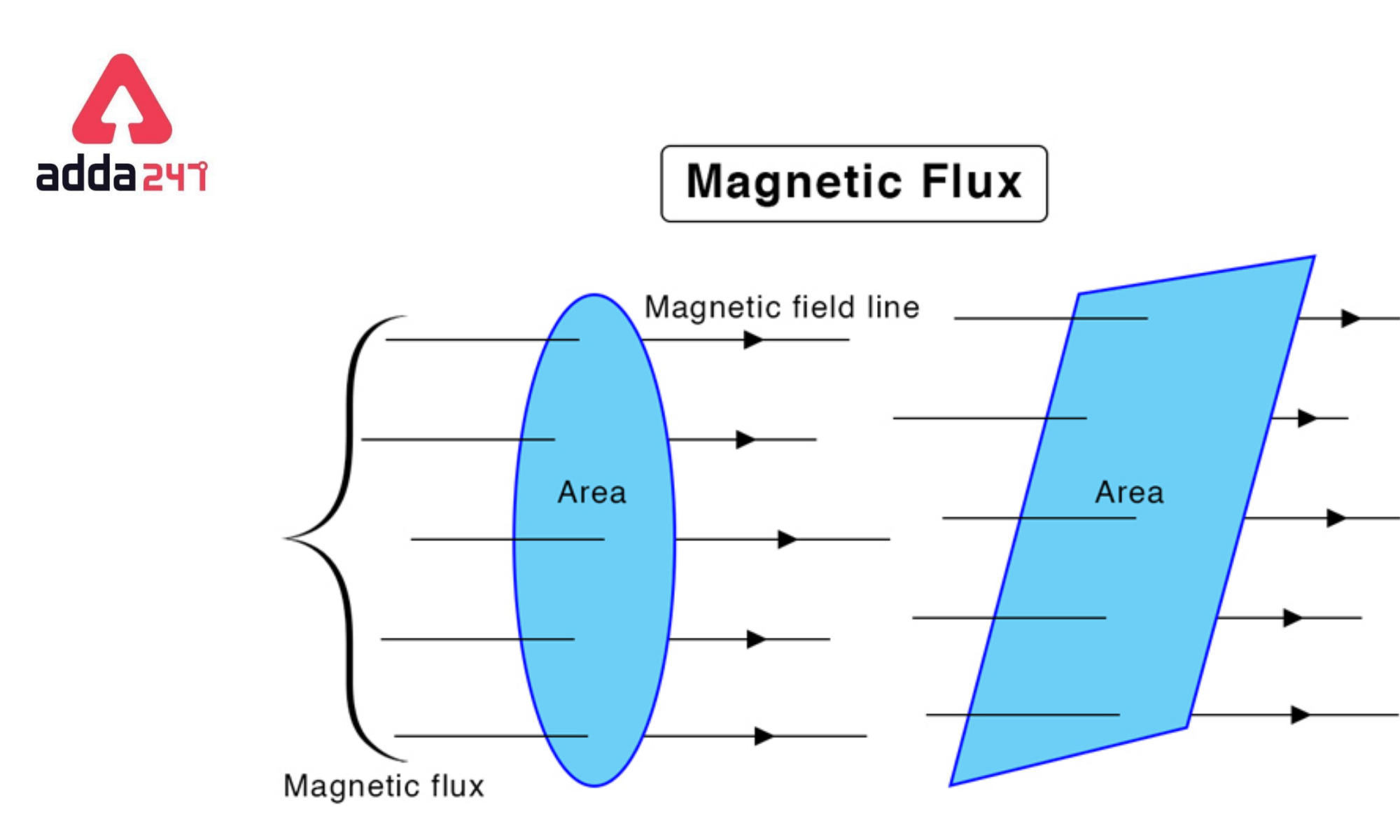Magnetic flux
The entire magnetic field that travels across a particular area is measured by magnetic flux. Magnetic Flux is a helpful tool for describing the effects of magnetic force on things in a specific location. The magnetic flux measurement is specific to the designated location.We can make the region any size and orient it in any direction in relation to the magnetic field.
If we consider a magnetic field in terms of field lines, each field line travelling through a particular area adds some magnetic flux. It’s also crucial to consider the angle at which the field line meets the region. A glancing angle field line will only contribute a small portion of the field to the magnetic flux. We only use the component of the magnetic field vector that is normal to our test region when computing the magnetic flux.
Flux
Flux refers to the flow or movement of something through a surface or across a boundary. It is a concept used in various fields, including physics, mathematics, and engineering. The specific definition and application of flux depend on the context in which it is used. Here are a few common interpretations of flux:
- Physics (Electromagnetism): In physics, flux refers to the flow of an electric field or magnetic field through a surface. Electric flux represents the number of electric field lines passing through a given area, while magnetic flux represents the number of magnetic field lines passing through a surface. The units of flux are typically measured in volts per meter (V/m) for electric flux and webers (Wb) for magnetic flux.
- Mathematics (Vector Calculus): In mathematics, specifically in vector calculus, flux is defined as the flow of a vector field through a surface. It represents the amount of a vector field passing through a surface per unit area. The mathematical concept of flux is often used in Gauss’s law, Stokes’ theorem, and the divergence theorem to relate the behavior of vector fields to the boundaries of closed surfaces or curves.
- Engineering (Fluid Dynamics): In fluid dynamics, flux refers to the rate of flow of a fluid through a given area or surface. It is commonly used to describe the mass, volume, or energy flow per unit time through a boundary. Flux is an important parameter in various engineering applications, such as heat transfer, fluid mechanics, and environmental engineering.
flux generally refers to the flow or movement of something (e.g., electric field, magnetic field, vector field, fluid) through a surface or across a boundary. The specific interpretation and calculations of flux depend on the particular field or context in which it is being used.
Flux Unit
The units of flux depend on the specific type of flux being discussed. Here are some commonly used units for different types of flux:
- Electric Flux: The unit of electric flux is the volt-meter (V·m) or the volt-meter squared (V·m²). Electric flux is calculated as the electric field strength (volts per meter) multiplied by the area (square meters) through which the field lines pass.
- Magnetic Flux: The unit of magnetic flux is the weber (Wb). Magnetic flux is the product of the magnetic field strength (teslas) and the area (square meters) perpendicular to the magnetic field lines.
- Heat Flux: The unit of heat flux is watts per square meter (W/m²). Heat flux represents the rate of heat transfer (in watts) per unit area (in square meters).
- Mass Flux: The unit of mass flux is typically kilograms per square meter per second (kg/(m²·s)). Mass flux measures the rate of mass flow (in kilograms) per unit area (in square meters) per unit time (in seconds).
- Radiative Flux: The unit of radiative flux is typically watts per square meter (W/m²). Radiative flux measures the power per unit area emitted or received by an object or surface.
These are just a few examples of flux and their corresponding units. Different types of flux have different units depending on the specific physical quantity being measured and the applicable equations or laws in the corresponding field of study.
Flux Density
Flux density refers to the amount of flux passing through a given area or volume. The specific units for flux density depend on the context in which it is being used. Here are some commonly used units for different types of flux density:
- Magnetic Flux Density: Magnetic flux density is also known as magnetic field strength or magnetic induction. The unit of magnetic flux density is the tesla (T) or, in some cases, the gauss (G). One tesla is equal to 10,000 gauss.
- Electric Flux Density: Electric flux density is a measure of the electric field strength in a given region. The unit of electric flux density is the coulomb per square meter (C/m²).
- Energy Flux Density: Energy flux density, also referred to as radiant flux density, represents the amount of energy passing through a specific area or volume. The unit of energy flux density is the watt per square meter (W/m²).
- Heat Flux Density: Heat flux density measures the rate of heat transfer per unit area. The unit of heat flux density is the watt per square meter (W/m²).
- Particle Flux Density: Particle flux density is a measure of the flow rate of particles per unit area or volume. The unit of particle flux density depends on the specific particles being considered and can be expressed, for example, as particles per square meter per second (particles/(m²·s)).
Magnetic flux Definition
The magnetic flux through a material is the surface integral of the real part of the magnetic field B over the same surface in Physics, specifically electromagnetism. It is commonly indicated by the symbols Φ or ΦB. The weber is the SI unit for magnetic flux, while the maxwell is the CGS unit. Magnetic flux is typically measured with a fluxmeter, which consists of measuring coils and electronics that calculate magnetic flux measurement by evaluating the change in voltage in the measuring coils.
The field line analogy is eliminated in more sophisticated physics, and the magnetic flux is properly defined as the surface integral of the normal component of the magnetic field travelling through a surface.
Magnetic flux Formula
The magnetic flux traveling through a surface of vector area S is constant if the magnetic field is constant is:
| Φ B = B ⋅ S = B S cos θ |
in which B is the magnetic field’s magnitude, θ is the angle between the magnetic field lines and its perpendicular, and S is the surface area.
Magnetic flux Density
Magnetic Flux Density is the quantity of magnetic flux per unit area measured perpendicular to the magnetic flux direction. Magnetic Field and Flux Density are interrelated by
| B=μH |
Magnetic flux refers to the total number of magnetic field lines that travel through a specific location. The permeability of the medium (μ) in which we are measuring the fields is the permeability in the magnetic flux formula. The B field is a vector field, meaning it has a magnitude and direction at every point in space.
The total number of magnetic field lines passing through a given area normally is called magnetic flux. In magnetic flux formula μ is the permeability of the medium (material) where we are measuring the fields. The B field is a vector field, which means it has a magnitude and direction at each point in space.
Magnetic flux Density unit
The magnetic flux traveling through a surface of vector area S is constant if the magnetic field is constant is:
| Φ B = B ⋅ S = B S cos θ |
in which B is the magnetic field’s magnitude, θ is the angle between the magnetic field lines and its perpendicular, and S is the surface area.
The magnetic field’s magnitude (the magnetic flux density) is measured in Wb/m2 (tesla),
Related Post:









 HPBOSE Compartment Date Sheet 2025 Out, ...
HPBOSE Compartment Date Sheet 2025 Out, ...
 RUHS Counselling 2025 Round 1 Seat Allot...
RUHS Counselling 2025 Round 1 Seat Allot...
 Bihar Board Dummy Registration Card 2026...
Bihar Board Dummy Registration Card 2026...










